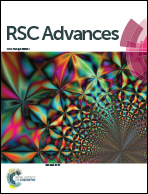Binder effect on the battery performance of mesoporous copper ferrite nanoparticles with grain boundaries as anode materials†
Abstract
Mesoporous copper ferrite (CuFe2O4) nanoparticles were prepared by citric acid and urea assisted combustion process. The local chemical modification obtained through addition of acid and base to the synthesis process, modifies the combustion reaction and it affects the crystalline phase, pore size and surface area of CuFe2O4 nanoparticles. The effect of grain boundary surfaces with different pore sizes on the electrical properties was explained using impedance spectroscopy results, and it was also reflected in the battery performance. The CR 2032 coin cells were fabricated using mesoporous CuFe2O4 nanoparticles with polyvinylidene difluoride (PVdF)/sodium alginate as binders; moreover, the effect of PVdF and alginate binders on the battery performance and coulombic efficiency were analyzed and were correlated to the area covered under oxidation and reduction cycles of cyclic voltammetry. CR 2032 coin cells were fabricated using mesoporous CuFe2O4 raw, acid and base samples with alginate binder and cycled at 1C rate to obtain the effect of crystallite size and surface area on the battery performance. The addition of alginate binder and its good adhesive nature improves the battery performance and retains the capacity for longer cycles.


 Please wait while we load your content...
Please wait while we load your content...